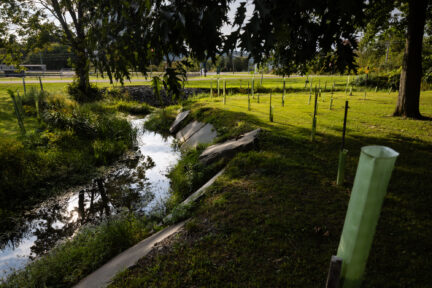Chesapeake Bay Program makes measured progress toward restoring the watershed
Experts report positive observations of pollution loads and living resource abundance.
The Chesapeake Bay Program and its partners are making measured progress toward the goals and outcomes of the Chesapeake Bay Watershed Agreement, as experts report positive observations of pollution loads and living resource abundance.
Released today, the Chesapeake Bay Program’s summary analysis of watershed health and restoration reveals early evidence of our new and renewed efforts to restore a complex and interconnected ecosystem. As reported in Bay Barometer: Health and Restoration in the Chesapeake Bay Watershed (2014-2015), recent assessments of water quality show encouraging nutrient and sediment loads that are below the 24-year average, and a welcome increase in the overall attainment of clean water standards. Data related to living resources show an increase in the acres of underwater grasses available to fish and shellfish and in the stream miles open to the movements of migratory fish. Data also show a rise in populations of young striped bass, adult female blue crabs and migrating American shad.
While the restoration of certain habitats remains slow—like the planting of riparian forest buffers and the installation of fencing to exclude livestock from streams, both of which suffer from insufficient technical assistance, landowner outreach and incentives—our partners remain committed to protecting and restoring the nation’s largest estuary. The final work plans that describe the key actions our partners will take over the next two years to achieve the agreement’s 31 outcomes will be released this spring.
The scientific data and information presented in Bay Barometer help us track the success of our work and provide the basis for our path forward in protecting the Bay. Because of the connections between pollution, water quality, living resources and wildlife habitat, it will take a steady effort from the entire Chesapeake Bay Program partnership to restore watershed health. Fluctuations in one part of the Bay ecosystem can impact countless others: the restoration of coastal wetlands can mean resilience against some impacts of climate change; the installation of green infrastructure to reduce stormwater runoff can mitigate urban heat island effects; improvements in water quality can mean healthier fish and shellfish; and engaging communities in environmental protection can mean a rise in the local stewardship of land, rivers and streams.
Facts
Highlights from the latest edition of Bay Barometer can be found below.
Abundant Life: Habitats
- Between 2012 and 2015, 817 stream miles were opened to fish passage, including almost 300 miles in Virginia and more than 500 miles in Pennsylvania. This marks an 82 percent achievement of the 1,000-mile goal.
- Between 2013 and 2014, the abundance of underwater grasses in the Chesapeake Bay rose 26 percent, from 59,711 to 75,835 acres. This marks an achievement of 41 percent of our 185,000-acre goal.
Abundant Life: Fish and Shellfish
- Between 2014 and 2015, the abundance of adult female blue crabs in the Chesapeake Bay rose 47 percent, from 68.5 million to 101 million. This number is below the 215 million target but above the 70 million overfishing threshold.
- Between 2000 and 2014, the abundance of American shad as measured in five Chesapeake Bay tributaries increased from 11 percent to 44 percent of the goal. The Potomac River has shown the most consistent rise in returning shad.
Clean Water
- Between October 2013 and September 2014, nitrogen, phosphorus and sediment loads were below the long-term average: approximately 285 million pounds of nitrogen, 17.5 million pounds of phosphorus and 3.62 million tons of sediment reached the Chesapeake Bay.
- During the 2012 to 2014 assessment period, 34 percent of the water quality standards for dissolved oxygen, water clarity or underwater grasses, and chlorophyll a for the Chesapeake Bay and its tidal tributaries were met. While this is below the 100 percent attainment needed for a healthy Bay, it marks a 17 percent rise from the percentage of clean water criteria attained during the previous assessment period.
Protected Lands
- Between 2010 and 2013, close to 572,000 acres of land in the Chesapeake Bay watershed were permanently protected from development. This marks an achievement of 29 percent of the goal to protect an additional two million acres from the 2010 baseline, and brings the total amount of protected land in the watershed to 8.37 million acres.
Engaged Communities
- Between 2010 and 2014, 86 public access sites were opened in the Chesapeake Bay watershed, bringing the total number of access sites in the region to 1,225. Virginia, Maryland and Pennsylvania have seen the biggest increases in access sites during this time, at 40, 20 and 16 new sites, respectively. The cumulative watershed-wide total marks a 29 percent achievement of the goal to add 300 new access sites to the region.
Issues
Determining the health of the Chesapeake Bay is as complex as the ecosystem itself. Tracking changes in environmental health over time gives scientists a better understanding of both natural variations in the environment and the long-term effects of our restoration work. In Bay Barometer, we offer our data in their clearest form so you can assess the health of our ecosystem and the progress we are making toward restoring it.
Importance
The data in Bay Barometer reflect the Chesapeake Bay’s health over the course of many years and, in some cases, decades. The publication offers a snapshot of the best available information from 2014 and 2015 on ecological health and our efforts to protect and restore the nation’s largest estuary.
Quotes
“This year’s Bay Barometer shows many of our indicators are moving in the right direction. We are seeing positive results from our efforts to restore balance to an important ecosystem that has suffered decades of damage. We must sustain and step up our efforts if we are going to succeed in the long run in dealing with climate change and other challenges.”
--- Nick DiPasquale, Director, Chesapeake Bay Program



